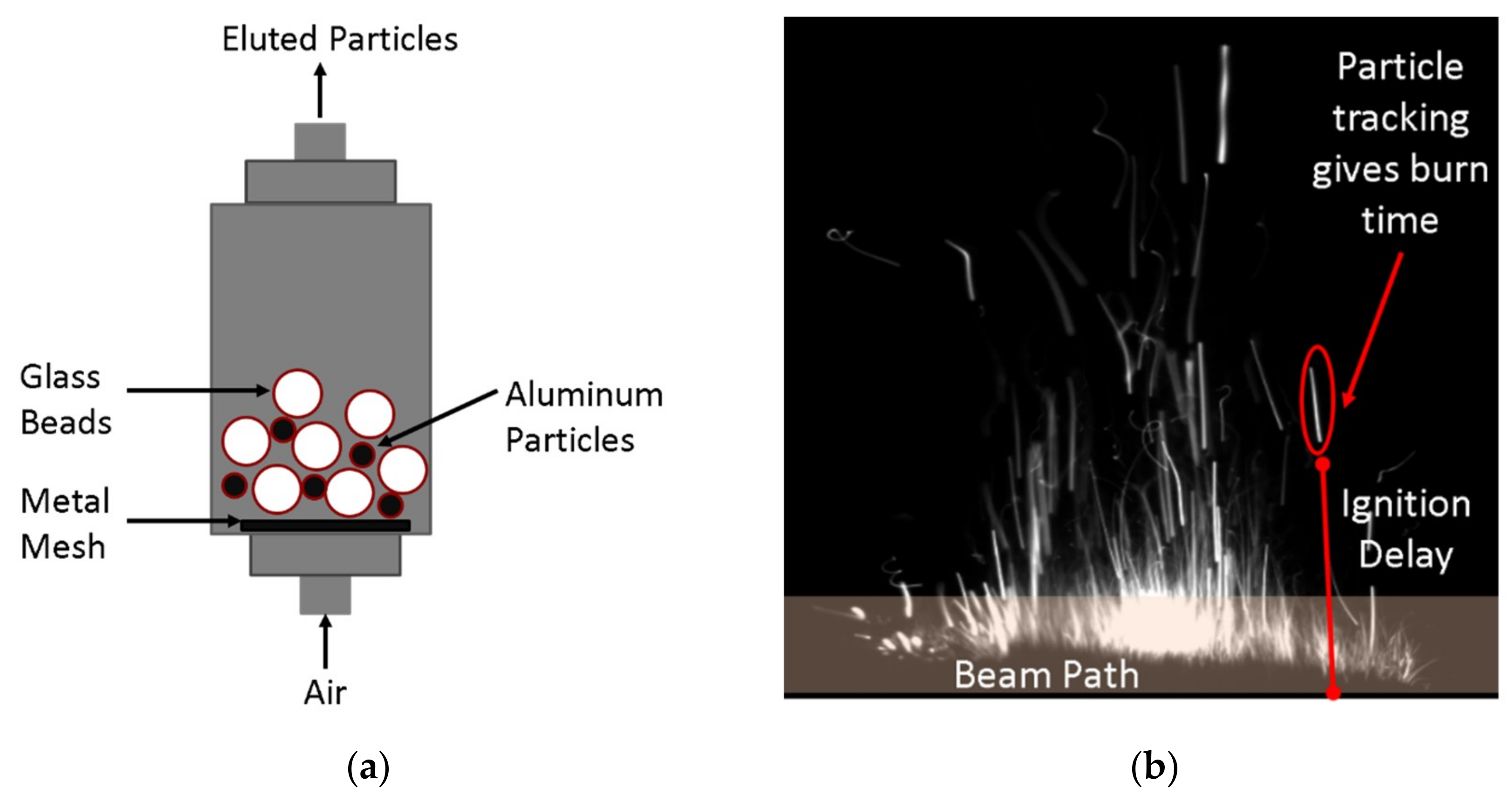Single Particle Combustion of Pre-Stressed Aluminum
Abstract
:1. Introduction
2. Materials and Methods
2.1. Synchrotron X-Ray Diffraction (XRD) Measurements
2.2. Single Particle Reactive Characterization
3. Results
4. Discussion
5. Conclusions
Author Contributions
Funding
Conflicts of Interest
References
- Kalman, J.; Demko, A.R.; Varghese, B.; Matusik, K.E.; Kastengren, A.L. Synchrotron-based Measurement of Aluminum Agglomerates at Motor Conditions. Comb Flame 2018, 196, 144–147. [Google Scholar] [CrossRef]
- Hill, K.J.; Warzywoda, J.; Pantoya, M.L.; Levitas, V.I. Dropping the Hammer: Examining Impact Ignition and Combustion Using Pre-stressed Aluminum Powder. J. Appl. Phys. 2017, 122, 125102. [Google Scholar] [CrossRef]
- Hill, K.J.; Tamura, N.; Levitas, V.I.; Pantoya, M.L. Impact Ignition and Combustion of Micron-scale Aluminum Particles Pre-stressed with Different Quenching Rates. J. Appl. Phys. 2018, 124, 115903. [Google Scholar] [CrossRef]
- Friedman, F.; Maček, A. Ignition and Combustion of Aluminum Particles in Hot Ambient Gases. Comb Flame 1962, 6, 9–19. [Google Scholar] [CrossRef]
- Washburn, E.B.; Webb, J.A.; Beckstead, M.W. The Simulation of the Combustion of Micrometer-sized Aluminum Particles with Oxygen and Carbon Dioxide. Comb Flame 2010, 157, 540–545. [Google Scholar] [CrossRef]
- Allen, D.; Krier, H.; Glumac, N. Heat Transfer Effects in Nano-aluminum Combustion at High Temperatures. Comb Flame 2014, 161, 295–302. [Google Scholar] [CrossRef]
- Lynch, P.; Krier, H.; Glumac, N. A Correlation for Burn Time of Aluminum Particles in the Transition Regime. Proc. Combust. Inst. 2009, 32, 1887–1893. [Google Scholar] [CrossRef]
- Mohan, S.; Trunov, M.A.; Dreizin, E.L. Heating and Ignition of Metallic Particles by a CO2 Laser. J. Prop. Power 2008, 24, 199–205. [Google Scholar] [CrossRef]
- Gill, R.J.; Mohan, S.; Dreizin, E.L. Sizing and Burn Time Measurements of Micron-sized Metal Powders. Rev. Sci. Instrum. 2009, 80, 064101. [Google Scholar] [CrossRef]
- Prenni, A.J.; Siefert, R.L.; Onasch, T.B.; Tolbert, M.A.; Demott, P.J. Design and Characterization of a Fluidized Bed Aerosol Generator: A Source for Dry, Submicrometer Aerosol. Aerosol Sci. Technol. 2000, 32, 465–481. [Google Scholar] [CrossRef]
- Boucher, R.F.; Lua, A.C. A Stable, High-concentration, Dry Aerosol Generator. J. Aerosol Sci. 1982, 13, 499. [Google Scholar] [CrossRef]
- Glass, M.; Kennedy, I.M. An Improved Seeding Method for High Temperature Laser Doppler Velocimetry. Comb Flame 1977, 29, 333–335. [Google Scholar] [CrossRef]
- Cashdollar, K.L.; Chatrathi, K. Minimum Explosible Dust Concentrations Measured in 20-L and 1 m3 Chambers. Comb Sci. Technol. 1993, 87, 157–171. [Google Scholar] [CrossRef]
- Kalejaiye, O.; Amyotte, P.R.; Pegg, M.J.; Cashdollar, K.L. Effectiveness of Dust Dispersion in the 20-L Siwek Chamber. J. Loss Prevent. Proc. Ind. 2010, 23, 46–59. [Google Scholar] [CrossRef]
- McCollum, J.; Pantoya, M.L.; Tamura, N. Improving Aluminum Particle Reactivity by Annealing and Quenching Treatments: Synchrotron X-ray Diffraction Analysis of Strain. Acta Mater. 2016, 103, 495–501. [Google Scholar] [CrossRef]
- Kunz, M.; Tamura, N.; Chen, K.; MacDowell, A.A.; Celestre, R.S.; Church, M.M.; Fakra, S.; Domning, E.E.; Glossinger, J.M.; Kirschman, J.L.; et al. A Dedicated Superbend X-ray Microdiffraction Beamline for Materials, Geo-, and Environmental Sciences at the Advanced Light Source. Rev. Sci. Instrum. 2009, 80, 035108. [Google Scholar] [CrossRef] [PubMed]
- Tamura, N. Strain and Dislocation Gradients from Diffraction: Spacially-Resolved Local Structure and Defects; Barabash, R., Ice, G., Eds.; Imperial College Press: London, UK, 2014; p. 125. [Google Scholar]
- Levitas, V.I.; McCollum, J.; Pantoya, M.L. Pre-stressing Micron-scale Aluminum Core-shell Particles to Improve Reactivity. Sci. Rep. 2015, 5, 7879. [Google Scholar] [CrossRef] [PubMed]
- Levitas, V.I.; McCollum, J.; Pantoya, M.L.; Tamura, N. Stress Relaxation in Pre-stressed Aluminum Core-Shell Particles: X-Ray Diffraction Study, Modeling, and Improved Reactivity. Comb. Flame 2016, 170, 30–36. [Google Scholar] [CrossRef]


| Particle Type | Mean (All Data) | Average (2 SD) | Average (3 SD) | Median |
|---|---|---|---|---|
| Burn Time (ms) | ||||
| UN | 1.08 | 1.37 | 1.08 | 1.2 |
| PS | 1.04 | 1.03 | 1.03 | 1 |
| SQ | 0.96 | 0.95 | 0.96 | 1 |
| Particle Type | Ignition Delay Time (µs) | |||
| UN | 13.79 | 9.88 | 12.42 | 6.42 |
| PS | 9.37 | 6.80 | 8.29 | 4.26 |
| SQ | 14.18 | 10.16 | 10.80 | 5.59 |
| Particle Type | Burn Time % Decrease from UN Al | |||
| PS | 4.37 | 24.86 | 4.48 | 16.67 |
| SQ | 11.34 | 30.67 | 11.47 | 16.67 |
| Particle Type | Ignition Delay Time % Decrease from UN Al | |||
| PS | 32.11 | 31.15 | 33.30 | 33.67 |
| SQ | −2.82 | −2.81 | 13.07 | 12.87 |
| Material | Dilatational Strain |
|---|---|
| UN Al | 1.5 × 10−6 |
| PS Al | 9.23 × 10−5 |
| SQ Al | 5.7 × 10−5 |
© 2019 by the authors. Licensee MDPI, Basel, Switzerland. This article is an open access article distributed under the terms and conditions of the Creative Commons Attribution (CC BY) license (http://creativecommons.org/licenses/by/4.0/).
Share and Cite
Hill, K.J.; Pantoya, M.L.; Washburn, E.; Kalman, J. Single Particle Combustion of Pre-Stressed Aluminum. Materials 2019, 12, 1737. https://doi.org/10.3390/ma12111737
Hill KJ, Pantoya ML, Washburn E, Kalman J. Single Particle Combustion of Pre-Stressed Aluminum. Materials. 2019; 12(11):1737. https://doi.org/10.3390/ma12111737
Chicago/Turabian StyleHill, Kevin J., Michelle L. Pantoya, Ephraim Washburn, and Joseph Kalman. 2019. "Single Particle Combustion of Pre-Stressed Aluminum" Materials 12, no. 11: 1737. https://doi.org/10.3390/ma12111737





